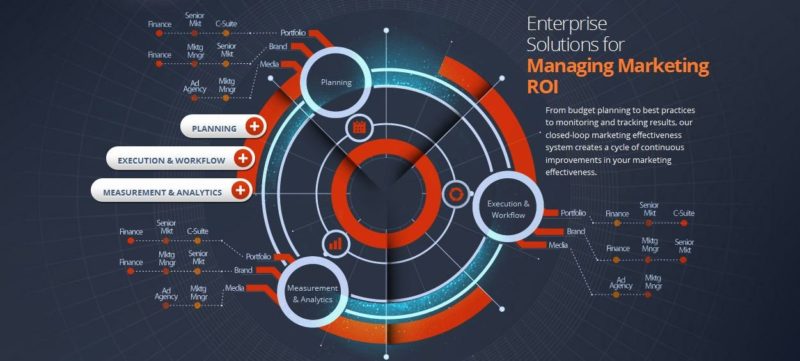Image: Entreprenuer
Marketing analytics comprises the processes and technologies that enable marketers to evaluate the success of their marketing initiatives by measuring performance (e.g., blogging versus social media versus channel communications) using important business metrics, such as ROI, marketing attribution and overall marketing effectiveness. In other words, it tells you how your marketing programs are really performing.
Marketing analytics gathers data from across all marketing channels and consolidates it into a common marketing view. From this common view, you can extract analytical results that can provide invaluable assistance in driving your marketing efforts forward.
Why marketing analytics is important
Over the years, as businesses expanded into new marketing categories, new technologies were adopted to support them. Because each new technology was typically deployed in isolation, the result was a hodgepodge of disconnected data environments.
Consequently, marketers often make decisions based on data from individual channels (website metrics, for example), not taking into account the entire marketing picture. Social media data alone is not enough. Web analytics data alone is not enough. And tools that look at just a snapshot in time for a single channel are woefully inadequate. Marketing analytics, by contrast, considers all marketing efforts across all channels over a span of time – which is essential for sound decision making and effective, efficient program execution.
What you can do with marketing analytics
With marketing analytics, you can answer questions like these:
- How are our marketing initiatives performing today? How about in the long run? What can we do to improve them?
- How do our marketing activities compare with our competitors’? Where are they spending their time and money? Are they using channels that we aren’t using?
- What should we do next? Are our marketing resources properly allocated? Are we devoting time and money to the right channels? How should we prioritize our investments for next year?
Three steps to marketing analytics success
To reap the greatest rewards from marketing analytics, follow these three steps:
- Use a balanced assortment of analytic techniques.
- Assess your analytic capabilities, and fill in the gaps.
- Act on what you learn.
Use a balanced assortment of analytic techniques
To get the most benefit from marketing analytics, you need an analytic assortment that is balanced – that is, one that combines techniques for:
- Reporting on the past.By using marketing analytics to report on the past, you can answer such questions as: Which campaign elements generated the most revenue last quarter? How did email campaign A perform against direct mail campaign B? How many leads did we generate from blog post C versus social media campaign D?
- Analyzing the present.Marketing analytics enables you to determine how your marketing initiatives are performing right now by answering questions like: How are our customers engaging with us? Which channels do our most profitable customers prefer? Who is talking about our brand on social media sites, and what are they saying?
- Predicting and/or influencing the future.Marketing analytics can also deliver data-driven predictions that you can use to influence the future by answering such questions as: How can we turn short-term wins into loyalty and ongoing engagement? How will adding 10 more sales people in under-performing regions affect revenue? Which cities should we target next using our current portfolio?
Assess your analytic capabilities, and fill in the gaps
Marketing organizations have access to a lot of different analytic capabilities in support of various marketing goals, but if you’re like most, you probably don’t have all your bases covered. Assessing your current analytic capabilities is a good next step. After all, it’s important to know where you stand along the analytic spectrum, so you can identify where the gaps are and start developing a strategy for filling them in.
For example, a marketing organization may already be collecting data from online and POS transactions, but what about all the unstructured information from social media sources or call-center logs? Such sources are a gold mine of information, and the technology for converting unstructured data into actual insights that marketers can use exists today. As such, a marketing organization may choose to plan and budget for adding analytic capabilities that can fill that particular gap. Of course, if you’re not quite sure where to start, well, that’s easy. Start where your needs are greatest, and fill in the gaps over time as new needs arise.
Act on what you learn
There is absolutely no real value in all the information marketing analytics can give you – unless you act on it. In a constant process of testing and learning, marketing analytics enables you to improve your overall marketing program performance by, for example:
- Identifying channel deficiencies.
- Adjusting strategies and tactics as needed.
- Optimizing processes.
Without the ability to test and evaluate the success of your marketing programs, you would have no idea what was working and what wasn’t, when or if things needed to change, or how. By the same token, if you use marketing analytics to evaluate success, but you do nothing with that insight, then what is the point?
Applied holistically, marketing analytics allows for better, more successful marketing by enabling you to close the loop as it relates to your marketing efforts and investments. For example, marketing analytics can lead to better lead nurturing and management, which leads to more revenue and greater profitability. By more effectively managing leads and being able to tie those leads to sales – which is known as closed-loop marketing analytics – you can see which specific marketing initiatives are contributing to your bottom line.
Source: SAS

